After 10 days away from my garden, I was keen to check in and see how things are coming along.
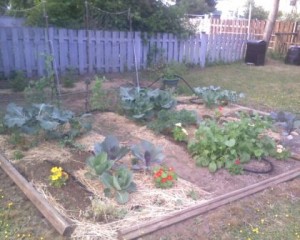 In a nutshell, stuff is growing! This in itself is a wonderful thing, which I don’t take for granted. I mean, if it were up to my expertise, the seeds I planted would be sunk. Fortunately, they know what to do without much help from me.
In a nutshell, stuff is growing! This in itself is a wonderful thing, which I don’t take for granted. I mean, if it were up to my expertise, the seeds I planted would be sunk. Fortunately, they know what to do without much help from me.
The broccoli is growing like crazy without much to show for it. I’m beginning to wonder if I’m supposed to be clipping off the lower leaves to help the plant focus on bearing fruit, so to speak. I’ll have to check into that. In the meantime, after dinner I did discover one floret which will be eaten soon. The book I checked recommended harvesting to encourage more growth, and that’s all the encouragement I need.
A few weeks back I mulched the garden via a couple of found bales of straw. As far as I can tell, the mulch isn’t doing much to keep the weeds out, but I think that may be because it’s not laid out thickly enough. This I can remedy.

Radishes Gone Wild
My mutant radishes keep wanting to go to seed. I’ve never seen such huge radish leaves in my life! I’ve chopped off countless seed stalks but they just keep coming. A couple of weeks ago I tested one of the radishes, which was long, thin, white (no hint of red in sight) and very sharp and peppery. Yum! But I’m not sure they are “ripe” since they do not resemble any of the pictures on the packages of 3 kinds of radishes I thought I planted. (Adding to the confusion is that the Scientist, in a fit of spring cleaning, seems to have tossed out my lovely, meticulously, handwritten garden map. Oops!)
The kale is coming along nicely, now I just need to find a recipe and try and figure out how to get the Scientist to try some. He’s not really a veggie kind of guy…unless there is butter or sugar slathered on for disguise. He has, however and thanks to my efforts, discovered that he quite likes asparagus as well as grilled bell peppers of all colours. This is progress!
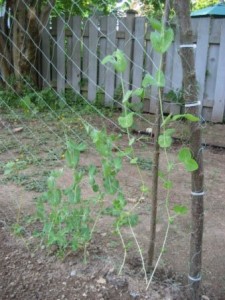
Happy Snow Peas
The snow peas are climbing like crazy, and it’s clear I need to get the climber mesh up at the end of plot C before the last ones planted start to topple. The green beans in the far corner, on the other hand, don’t seem to happy. I may need to move them out of that low lying area and into a new spot. Or add some dirt and replant them there?
And finally the bell peppers. Those poor guys have been completely eclipsed by the broccoli and are now completely shaded. When I originally planted, the plan was to keep the smaller stuff in back. Note to self: broccoli grows big, fast. Peppers, not so much.
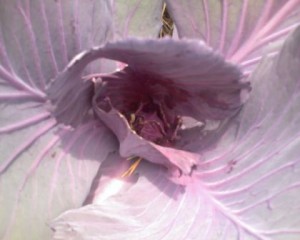 Something has completely gorged on one of my red cabbages. The entire inner, most tender young leaves have been eaten beyond salvage. I thought about ripping out the plant, but perhaps it’s better to leave it there as a bug decoy?
Something has completely gorged on one of my red cabbages. The entire inner, most tender young leaves have been eaten beyond salvage. I thought about ripping out the plant, but perhaps it’s better to leave it there as a bug decoy? 
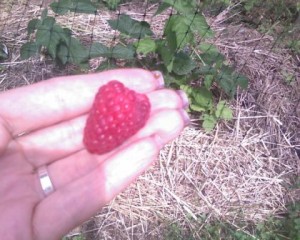 Along with the bounty of broccoli the first week in July, I also harvested a huge bag of
Along with the bounty of broccoli the first week in July, I also harvested a huge bag of 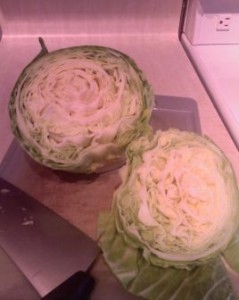 The cabbage I harvested was a full 6″ in diameter once all the outer, ratty looking leaves were removed. That’s bigger than it sounds! The thing that surprised me is that it’s crisp, juicy and crunchy compared to the ones I buy at the supermarket.
The cabbage I harvested was a full 6″ in diameter once all the outer, ratty looking leaves were removed. That’s bigger than it sounds! The thing that surprised me is that it’s crisp, juicy and crunchy compared to the ones I buy at the supermarket. 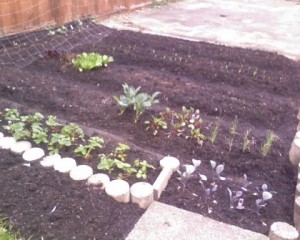 Back when I started this
Back when I started this 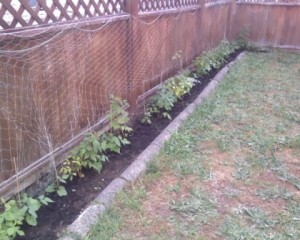 In the front, a multitude of raspberry plants (enough to make the Scientist jealous) are interspersed with beans and peas.
In the front, a multitude of raspberry plants (enough to make the Scientist jealous) are interspersed with beans and peas. In a nutshell, stuff is growing! This in itself is a wonderful thing, which I don’t take for granted. I mean, if it were up to my expertise, the seeds I planted would be sunk. Fortunately, they know what to do without much help from me.
In a nutshell, stuff is growing! This in itself is a wonderful thing, which I don’t take for granted. I mean, if it were up to my expertise, the seeds I planted would be sunk. Fortunately, they know what to do without much help from me.

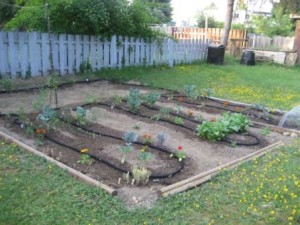 (I now actually hope for the occasional rainy, summer day. This is VERY odd.)
(I now actually hope for the occasional rainy, summer day. This is VERY odd.)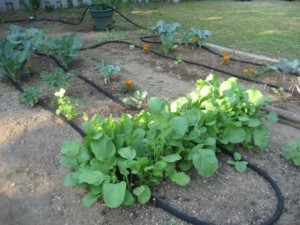 When I arrived at the garden in the middle of last week I discovered that the radishes were not only growing like crazy, they were getting ready to seed. I quickly trimmed off all of the large stalks to ensure that doesn’t happen. I’ve never seen radish greens get so large. Is this normal?
When I arrived at the garden in the middle of last week I discovered that the radishes were not only growing like crazy, they were getting ready to seed. I quickly trimmed off all of the large stalks to ensure that doesn’t happen. I’ve never seen radish greens get so large. Is this normal?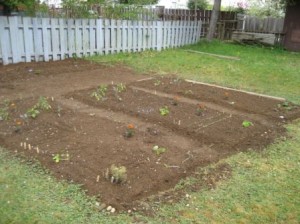 In the ongoing adventures of the
In the ongoing adventures of the 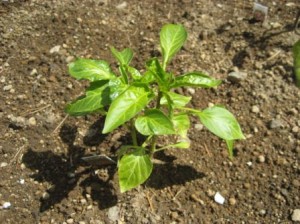 Then came the ill-fated squash episode. (A moment of silence please.)
Then came the ill-fated squash episode. (A moment of silence please.)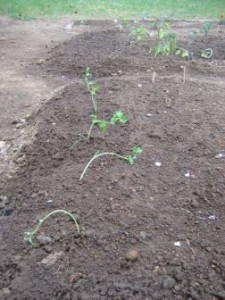 I did see a squash sprouting in the garden all on it’s own, the other day. I guess there were two seeds in one of the peat pucks. The first one died of frostbite and the second one is now checking things out. Maybe it’s an acclimatization thing. I’m sending it many happy, growing thoughts.
I did see a squash sprouting in the garden all on it’s own, the other day. I guess there were two seeds in one of the peat pucks. The first one died of frostbite and the second one is now checking things out. Maybe it’s an acclimatization thing. I’m sending it many happy, growing thoughts. Step I of the Seedling Saga is complete and Step II is underway — the little blighters (hmmm, maybe that’s not a good thing to say of seedlings) have moved on to bigger and better accommodations in mini plant pots of their own.
Step I of the Seedling Saga is complete and Step II is underway — the little blighters (hmmm, maybe that’s not a good thing to say of seedlings) have moved on to bigger and better accommodations in mini plant pots of their own.